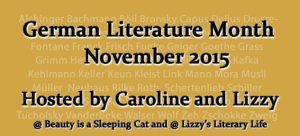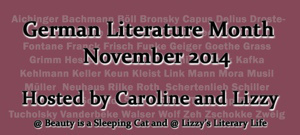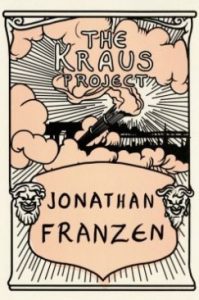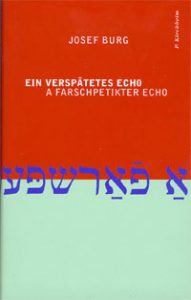This blog post is part of the German Literature Month, hosted by Lizzie (Lizzies Literary Life) and Caroline (Beauty is a Sleeping Cat)
Austria 1938. Andreas Kain, a renowned writer and his wife Eva, live in a beautiful villa just outside Vienna. What could be a normal and fulfilled life in the “loveliest city of Central Europe” turns for Kain, Eva, and Werner – Kain’s brother with whom he has a loving but nevertheless troubled relationship – into a nightmare: it is the time of the Anschluss, the Nazis are triumphing also in Austria, and for Jews like the three main characters of Veza Canetti’s novel The Tortoises (Die Schildkröten) a time of growing humiliations and deadly dangers has begun. The bank accounts of the Jews are frozen, those among them who have a regular job are dismissed, and the homes and furniture of Jewish households are being “requisitioned”. And that will be just the beginning.
While Kain and Eva have to leave their home, they have nowhere to go and visas are getting unattainable. Hilde, a Jewish girl from the neighborhood, tries to find a rather grotesque way out of this situation: with her father’s money and her charms for whom one of the new Nazi neighbors falls, she intends to hire or even buy a private airplane with which the whole group could possibly leave Austria (illegally), a project that is obviously doomed from the very beginning.
The Tortoises is a brilliant novel. Not only because of Veza Canetti’s ability to describe her own ordeal – the book is autobiographical – in an elegant, beautiful prose (well translated by Ian Mitchell). If you ever asked yourself how it was possible that the Nazis took hold of the big majority of Germans and Austrians within such a short time and how – at least on the surface – normal and otherwise decent people turned into Nazis or willing followers seemingly out of the blue then you should read this book. It gives a haunting description of the paranoid atmosphere in Vienna after the Anschluss.
Veza Canetti’s language is Viennese – elegant and always slightly ironic. The plays of Johann Nestroy, the prose of Arthur Schnitzler, the satiric furor of Karl Kraus, they all resonate in her writing. And she can write exceptionally well dialogues that sound as if they come directly from a Volksstück of Ödön von Horvath. The Nazis are ridiculous and pathetic figures; the name of the main villain in the book is Pilz (=mushroom), and this gives Frau Wlk (whose Czech name means “wolf”), the cleaner, an opportunity to denigrate this man but at the same time we readers get an insight in the mentality of even good-natured people like the landlady who is suddenly impressed by the Nazis:
“His name is Pilz-Mushroom! Toadstool, Mould, Fungus, Frau Wlk goes through all the variations. He lives down there where she lives, he’s a brownshirt, a bigwig, because he has a low number. Having a low number means he was one of the very first to be in the National Socialist Party….It seems that this low number exudes a fascinating effect. Because Frau Wlk was complaining. Even the landlady, here in this house, who is so kind, for whom she cleans the house, even she has been taken in. She who, after all, goes to church every Sunday. Who puts her last penny into the collection box to pay for a new figure of the Holy Virgin. Here in this house, the right atmosphere reigns to corrupt the landlady. The Mushroom came up and immediately won her over. And, simply because he has promised her South Tyrol, the landlady, who is so persnickety, is letting him move in here.”
Another “horvathesque” element are the dialogues between Pilz and Kain and his wife – on the surface polite (“Herr Ingenieur!” “Herr Doktor!”) and considering the changed circumstances even funny – but there can be no doubt that the new rulers will ruthlessly execute their program of extermination of the weak and of the “inferior” races, particularly the Jews.
While this is at least in the first days after the Anschluss not yet visible in the bourgeois villa neighborhood where Kain – the name is alluding not only to the biblical Kain but also to Peter Kien, the main character of Elias Canetti’s novel Auto-da-fé – and Eva are living, the open brutality of the new regime is evident from the very beginning in less privileged areas of the city. But also in the villa suburb, the signs are clear: a sparrow, and later a dog are killed by one of the new Nazis in front of a group of children to “teach” them that the weak and the useless have to be wiped out mercilessly. And the tortoises to which the title of the novel is referring, are branded with a swastika by another Nazi and sold as souvenirs, but some of them can be saved by the good-hearted Andreas Kain. As Schopenhauer says in The Basis of Morality:
“Compassion for animals is intimately associated with goodness of character, and it may be confidently asserted that he who is cruel to animals cannot be a good man.”
The novel is also a book about the relationship between the brothers Andreas and Werner, and is mirroring the relationship between Elias Canetti, Veza’s husband, and his brother Georges. In this respect it is not only interesting to read Elias Canetti’s autobiography (which mentions Veza’s great importance for Elias Canetti’s intellectual development, but doesn’t say a word about the fact that Canetti’s first wife was an exceptional author in her own right), but also the correspondence between Elias, Georges, and Veza Canetti that was published a few years ago.
The Tortoises was completed after the Canettis could escape to England in the very last moment, but never published during Veza’s lifetime. She published very little during her life and in a bout of depression destroyed the manuscripts of most of her unpublished works. During the last years of Elias Canetti’s life, he published/re-published her remaining works. Veza Canetti is one of the greatest prose writers of the 20th century in German language. It is high time to discover her.
Veza Canetti: The Tortoises, translated by Ian Mitchell, New Directions Books, New York 2001; Die Schildkröten, Carl Hanser Verlag, München 1999
Veza Canetti / Elias Canetti: “Dearest Georg!”: Love, Literature, and Power in Dark Times, The Letters of Elias, Veza, and Georges Canetti, 1933-1948, translated by David Dollenmayer, Other Press, New York 2010; Briefe an Georges, Carl Hanser Verlag, München 2006
For German speakers I recommend also the performance “Der Herr Karl” by Helmut Qualtinger, a truly revealing portrait of a (fictional) Nazi follower in Vienna – where until today a considerable part of the population views itself – quite in contrast to the overwhelming and frenetic support of the biggest part of the Austrian population for the Nazis after the Anschluss – as “the first victims of the Nazis”.
© Thomas Hübner and mytwostotinki.com, 2014-5. Unauthorized use and/or duplication of this material without expressed and written permission from this blog’s author and/or owner is strictly prohibited. Excerpts and links may be used, provided that full and clear credit is given to Thomas Hübner and mytwostotinki.com with appropriate and specific direction to the original content.








 Facebook
Facebook RSS
RSS Twitter
Twitter